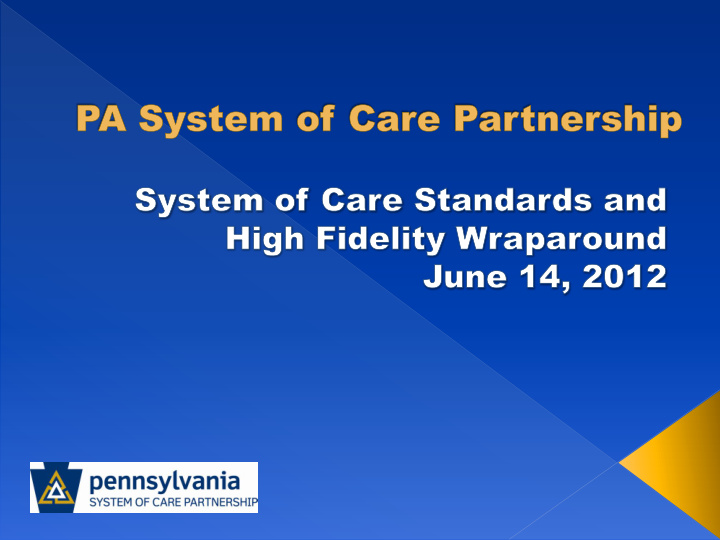



VISION Every youth and family in Pennsylvania will be able to access and navigate a unified network of effective services and supports that are structured in adherence to System of Care Values and Principles. MISSION The youth, family, and system leaders of Pennsylvania will work as equal and trusted partners for the purpose of creating sustainable change which will empower youth, families, and all youth serving systems to be responsible and accountable for outcomes that lead to the fulfillment of hopes and dreams. 2
Youth driven Family driven Working in equal partnership on leadership teams Integrating child-serving systems in partnership with youth and families Acknowledging and valuing natural and community supports Assuring cultural and linguistic competence Gathering and reporting data for evaluation and continuous quality improvement Implementing High Fidelity Wraparound for the most complex situations 3
A minimum of 25% of the members on the leadership team are youth, who share equal responsibility with family & system partners at all meetings and activities. Guidelines/policies for county leadership ensure youth members are prepared, supported, comfortable, and above-all valued, while also giving youth multiple outlets to make their voice heard. 4
The County Leadership Team partners with and supports local youth initiatives and/or actively facilitates the development of youth efforts and leadership in the community, with a focus on continuation and sustainability of any such youth activities. Child-Serving System principles and processes require youth voice as a standard practice, with several youth meaningfully participating in advisory boards and/or in an advisory capacity to the county child-serving systems. 5
Opportunities for youth will be made available in each respective child-serving system, including support for volunteering, employment and/or mentoring roles; and youth within the system will be given the tools needed to expand their leadership opportunities moving forward. Youth are given/taught the information and skills needed to make informed decisions about their own care, of which youth have a primary decision making role regarding their own care and overall well-being. 6
The County Leadership Team (CLT) is comprised of no less than 25% family members, representing the system of care target population Family leaders have the skills, information and the necessary supports to fully participate as equal partners in the governance team, and all of its activities. All county level youth-serving systems are improved by and held accountable to families. 7
Families have multiple opportunities to enhance their competence and confidence so they can provide leadership, support and advocacy. Family support is available to all interested families in order to improve youth and family outcomes. 8
Families have the information and skills to make informed decisions with and for their family members. Families and systems have shared responsibility for engagement to ensure informed decision-making. Families have a primary decision making role regarding their child's care and overall wellbeing. 9
At least half of the State Leadership Team (SLT) membership is made up of youth and family members, in equal numbers, who are representative of the population of focus. 10
For every youth and her/his family, systems coordinate efforts to complete a comprehensive, individualized assessment process, at or near the point of intake, that is used and shared amongst all involved child-serving systems. 11
Data and information is frequently shared and easily accessible to all involved child- serving systems. Individual youth and family information is appropriate shared in order to effectively develop and execute their single plan of care. Cumulative data is shared in order to inform a continuous quality improvement process. 12
There is an ongoing, systematic process for recognizing and enhancing the strengths, as well as identifying and addressing the barriers that affect implementation of fully integrated, cross-system plans. 13
A county’s HFW team informs all of these standards by contributing information from their work with youth and families to the County Leadership Team’s (CLT’s) activities. This information insures that 1) the county’s resource list is comprehensive, accurate, and driven by local youth and family needs; 2) the CLT continues to understand the value of unpaid supports; and 3) supports are valued for all HFW participants. 14
CLC standards are also all informed by HFW, as the work with youth and families within their communities helps HFW staff to: Understand the demographics of their county Suggest specific culture brokers that might enhance the CLT Acknowledge some of the strongest community supports for each cultural group Express any needs for materials in other languages Insure that CLC needs are met for all HFW participants 15
HFW staff should always understand the reasons for, benefits of, and any risks related to youth and family participation in any evaluations. HFW can help youth and families to understand evaluation and CQI activities, including their roles in it. HFW outcomes, fidelity and costs are key tools in successful implementation and sustainability of a SOC. 16
Recommend
More recommend